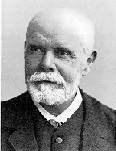

 Léon Walras (1834-1910)
Léon Walras (1834-1910)
Jevons' Theory of Political Economy (1871) was not well received when it appeared, but it was read.
Menger's Principles of Economics (1871) was both read and well received, at least in his own country. But
Walras's two-part Elements of Pure Economics (1844-77) was monstrously neglected everywhere despite his
indefatigable efforts to get the book noticed. That was in part because Walras set himself a task that
went beyond Jevons and Menger, his co-discoverers of marginal utility theory, namely, to write down and
solve the first multi-equational model of general equilibrium in all markets. In addition, Walras went
far beyond Jevons in employing a mathematical mode of exposition, and this was enough to scare off most of
his contemporary readers. But whereas Jevons and Menger are now regarded as historical landmarks, rarely
read purely for their own sake, posthumous appreciation of Walras's monumental achievement has grown so
markedly since the 1930s that he may now be the most widely-read nineteenth-century economist after
Ricardo and Marx, particularly since the translation of the Elements into English in 1954.
....
© Mark Blaug, Great Economists Before Keynes: An Introduction
to the Lives and Works of One Hundread Great Economists of the Past
, Brighton: Wheatsheaf, 1986. In Stauffer Library: HB76 .B62
1986t
 Léon Walras (1834-1910)
Léon Walras (1834-1910)

 Léon Walras (1834-1910)
Léon Walras (1834-1910)